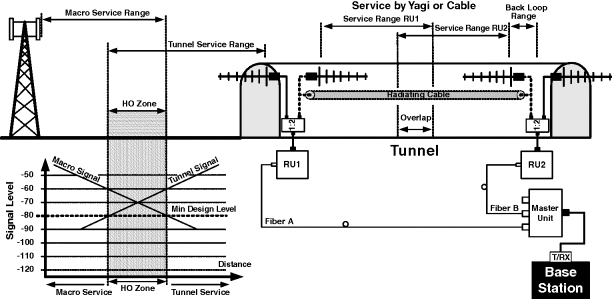11.1 The Typical Tunnel Solution
The typical tunnel coverage system is illustrated in Figure 11.1 for a car or rail tunnel; showing a short tunnel being served inside the tunnel by yagi antennas or radiating cable. Typically, the RF signal from the base station covering the tunnel will be distributed by a fiber optical DAS from a central base station location. When using the yagi antenna option in the tunnel it will often be possible to some extent to take advantage of the back lobe footprint from the yagi antennas to cover some of the tunnel/area. This can be useful in the platform area; if you are covering the tunnel itself with yagi antennas it will often be possible to cover the platform itself with the back loop from a yagi antenna near the tunnel entrance. The tunnel system must also provide sufficient signal level in the handover zones to the external macro network, as well as any overlapping zones between cells internally in the tunnel system, typically for larger tunnel systems.
Figure 11.1 The typical tunnel coverage system

But before even starting on designing the tunnel DAS solution it is very important to obtain some basic information in order to construct a link budget, and start the actual design work.
One of the most important parameters in the RF design process is the penetration loss into the train coach; don't even think about starting the RF planning before ...
Get Indoor Radio Planning: A Practical Guide for GSM, DCS, UMTS, HSPA and LTE, Second Edition now with the O’Reilly learning platform.
O’Reilly members experience books, live events, courses curated by job role, and more from O’Reilly and nearly 200 top publishers.

